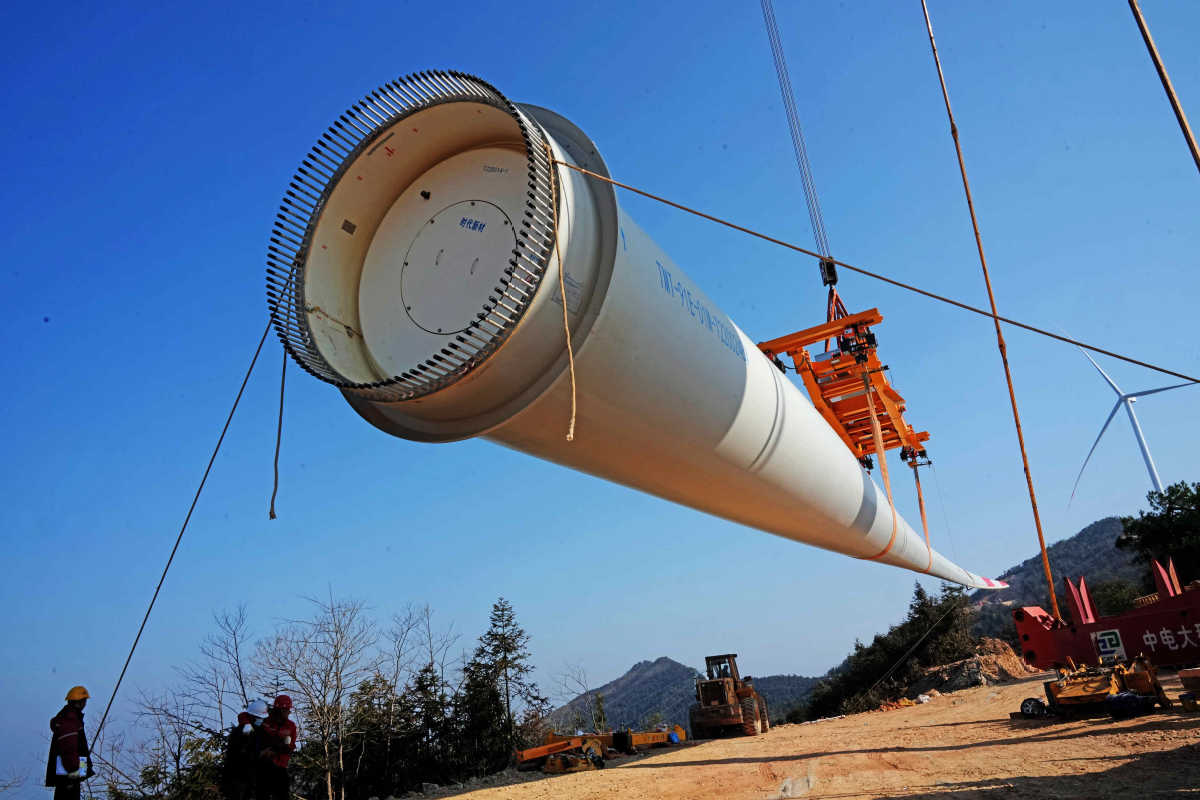Paired assistance provides power for green development (2)
A fan blade is lifted at a wind farm in Liuzhou, Guangxi Zhuang autonomous region, in January. LONG TAO/FOR CHINA DAILY
Development bases
The 2022 Beijing Winter Olympics and Paralympics Games were the first such events at which every venue was supported by renewable energy. The feat was made possible by a flexible direct current power grid that connected Beijing with a renewable energy demonstration zone in Hebei's Zhangjiakou city, which boasts rich wind and solar resources.
Having started operations in June 2020, the grid can transmit 22.5 billion kilowatt-hours of renewable power to Beijing every year, roughly 10 percent of the capital's annual electricity needs. That helps to reduce carbon dioxide emissions by more than 20 million metric tons per annum.
Last year, the capital also established a cooperation mechanism for the development of green electricity with Inner Mongolia, according to Mu Peng, head of the Beijing Commission of Development and Reform.
Construction of a new energy development base that will serve Beijing as one of its customers has started in Togtoh, a county in Hohhot, Inner Mongolia's capital, Mu said when he reported to the first session of the 16th Beijing Municipal People's Congress in January.
A major project at the base is a wind and solar power plant with total installed capacity of 2 million kilowatts. Construction began in June and the plant is expected to become fully operational by the end of this year, said Yuan Dongsheng, general manager of Inner Mongolia Datang International Tuoketuo Power Generation, the company building the facility.
When completed, the project, with total investment of some 12 billion yuan, will generate more than 4.1 billion kWh of electricity a year, cutting the use of standard coal by 1.4 million tons and reducing carbon dioxide emissions by 3.5 million tons, according to Yuan.
"By establishing a green, low-carbon, clean and highly efficient energy system, the project will help Beijing and Inner Mongolia accelerate their efforts to peak carbon dioxide emissions and become carbon neutral," he said.
Yuan added that the project will also help drive economic growth in the area.
Construction of the base has injected impetus into the development of the new energy program and the introduction of manufacturing industries for renewable energy equipment, thus driving the upgrading of Hohhot's energy sector, he said.
During the construction period, more than 2,000 workers are expected to be employed. Once it becomes operational, the plant will bolster local tax revenue, he said.
He added that the project will also raise the utilization rate of land resources in the surrounding rural areas.
In 2021, Inner Mongolia sent 50 billion kWh of renewable energy to other regions, about 20 percent of the total power it transferred that year, according to the regional development and reform commission in response to questions from China Daily.
 |  |
Photos
Related Stories
- Chinese modernization responsible for China, benefits the world
- China to continue transition to green development
- Green development emphasized at local "two sessions"
- Green professions promote low-carbon development in China
- China's Green Development in the New Era: Adjusting and Improving the Industrial Structure
- China issues white paper on green development
- China tops world in key green areas, report says
- China has set up new-type protected area system: white paper
- Remarkable progress made in promoting green and low-carbon energy: white paper
- China accelerates building of a green transport network: white paper
Copyright © 2023 People's Daily Online. All Rights Reserved.










